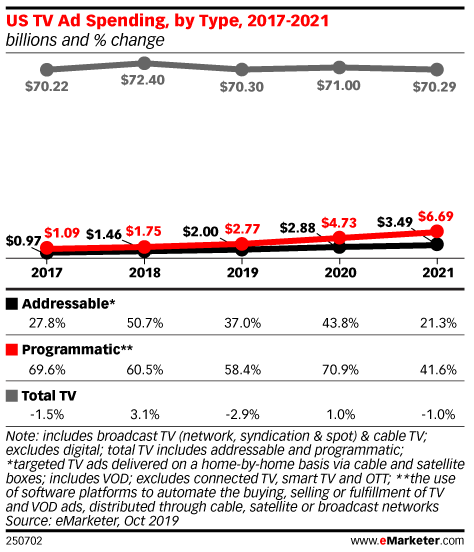Addressable advertising that lets marketers target individual households on linear TV will revolutionize the way broadcast networks sell their commercial inventories and fuel higher spending. With TV ratings company Nielsen last month saying it would start measuring addressable ads on a national basis next year, a major barrier to spending growth will recede.
“What we saw this year for the first time is programmers actually having the capability to sell addressable. That means the sky is the limit as far as growth is concerned,” Matt McLeggon, vice president of advanced TV at video advertising platform SpotX, said in this interview with Beet.TV.
He predicted that estimates for 20% growth in spending on addressable ads to $3.5 billion next year may be too conservative as network inventory opens up. Programmers have 14 minutes an hour to sell, or seven times the amount allocated to multichannel programming distributors (MVPDs) that have sold addressable ads for years.
“I think you’ll see that number be much higher,” McLeggon said. “You can expect to see SpotX at the forefront of that as well.”
Digital Video Roots
The company’s roots are in digital video advertising that has been inherently addressable because it’s sent to connected devices like desktop computers, mobile phones and smart TVs.
“What we’ve done now is extend these same tools, same technologies into the linear, addressable space,” he said. “We have a growing number of linear touchpoints. In some cases, we’ve integrated directly into traditional set-top boxes, but many of our clients — programmers, broadcasters, networks — they’re working with organizations like Project OAR. We’re working with those companies to bring programmatic into the addressable space at the smart TV level as well.”

Project OAR is an effort led by electronics maker Vizio to develop standards for addressable advertising. The On Addressability consortium from Comcast, Charter and Cox, and Nielsen’s Advanced Video Advertising effort are the other two major industry groups developing standards.
Addressable advertising promises to improve the user experience as viewers see ads that are more relevant, while “frequency capping” prevents the number of times a viewer sees the same ad repeatedly. SpotX provides a way for advertisers to target audiences as they consume media on different devices and channels, including over-the-top (OTT) services for connected devices.
“If you’re using a single platform, in this case being SpotX, to execute across linear, addressable as well as OTT, you’re going to have holistic controls over frequency capping and pacing,” McLeggon said. “Really, any type of campaign metric is going to be unified across traditional as well as programmatic.”
SpotX is mindful of the privacy issues that come with the practice of targeting consumers based on what’s known about them. Privacy has become a more significant concern amid news reports about data breaches and identity theft, leading lawmakers in several regions to enact stricter rules on data sharing.
SpotX has a privacy-compliant targeting solution called “Audience Lock” that gives companies the ability to hone their targeting while also protecting valuable data.
“We take privacy very seriously. We comply with all applicable laws, policies and regulations, which change by platform, change by region — even state,” McLeggon said. “We’ve been at the forefront of helping those standards be adopted in the industry.”
You are watching “Addressable Advertising: A New Reality for Linear TV,” a Beet.TV leadership series presented by SpotX. For more videos, please visit this page.




































